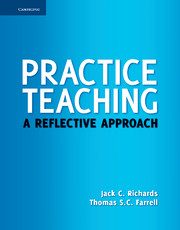Book contents
- Frontmatter
- Contents
- Introduction
- Chapter 1 Learning to Teach Through Practice Teaching
- Chapter 2 The Nature of Teacher Learning
- Chapter 3 Understanding the Teaching Context
- Chapter 4 Working With Your Cooperating Teacher
- Chapter 5 Planning Your Teaching
- Chapter 6 Teaching an Effective Language Lesson
- Chapter 7 Classroom Observation in Teaching Practice
- Chapter 8 Creating an Effective Classroom Learning Environment
- Chapter 9 Developing Learner-Centered Teaching
- Chapter 10 Classroom Discourse and Communication
- Chapter 11 Exploring Your Own Teaching
- Chapter 12 After Teaching Practice
- References
- Author Index
- Subject Index
Chapter 1 - Learning to Teach Through Practice Teaching
Published online by Cambridge University Press: 05 October 2012
- Frontmatter
- Contents
- Introduction
- Chapter 1 Learning to Teach Through Practice Teaching
- Chapter 2 The Nature of Teacher Learning
- Chapter 3 Understanding the Teaching Context
- Chapter 4 Working With Your Cooperating Teacher
- Chapter 5 Planning Your Teaching
- Chapter 6 Teaching an Effective Language Lesson
- Chapter 7 Classroom Observation in Teaching Practice
- Chapter 8 Creating an Effective Classroom Learning Environment
- Chapter 9 Developing Learner-Centered Teaching
- Chapter 10 Classroom Discourse and Communication
- Chapter 11 Exploring Your Own Teaching
- Chapter 12 After Teaching Practice
- References
- Author Index
- Subject Index
Summary
INTRODUCTION
Practice teaching is a part of most teacher education programs in language teaching and is intended to provide a link between the academic courses you studied in your university or other institutional TESOL program and the “real” world of teachers and students in a language-learning classroom (Brenes-Carvajal 2009; Farrell 2007). Many teachers find their practice-teaching experience to be one of the most useful courses they took during their teacher preparation, as these teachers confirm:
Teaching practice gave me a taste of teaching proper. It presented to me the tip of what to expect and thus allowed me to prepare myself better mentally for real teaching.
Mariana, BrazilPractice teaching gave me the chance to observe my cooperating teacher, and this allowed me to make different mental notes about how to deal with problems that sometimes come up in a lesson.
Yono, JapanI learned a lot from teaching practice. It allowed me to put some ideas and thoughts from my teacher education courses into actual practice. It provided a kind of testing ground for me to try out different approaches to teaching.
Mee-Ho, KoreaPractice teaching serves a number of goals (Baird 2008). Perhaps the most obvious one is for you to have an opportunity to apply some of the things you have studied in your academic and teacher-training courses. Your coursework will have included not only the theoretical knowledge expected of today's language teachers – often derived from courses in areas such as second language acquisition, linguistics, and discourse analysis – but also the practical knowledge derived from coursework in areas such as methodology, materials design, and language assessment.
- Type
- Chapter
- Information
- Practice TeachingA Reflective Approach, pp. 3 - 14Publisher: Cambridge University PressPrint publication year: 2011



